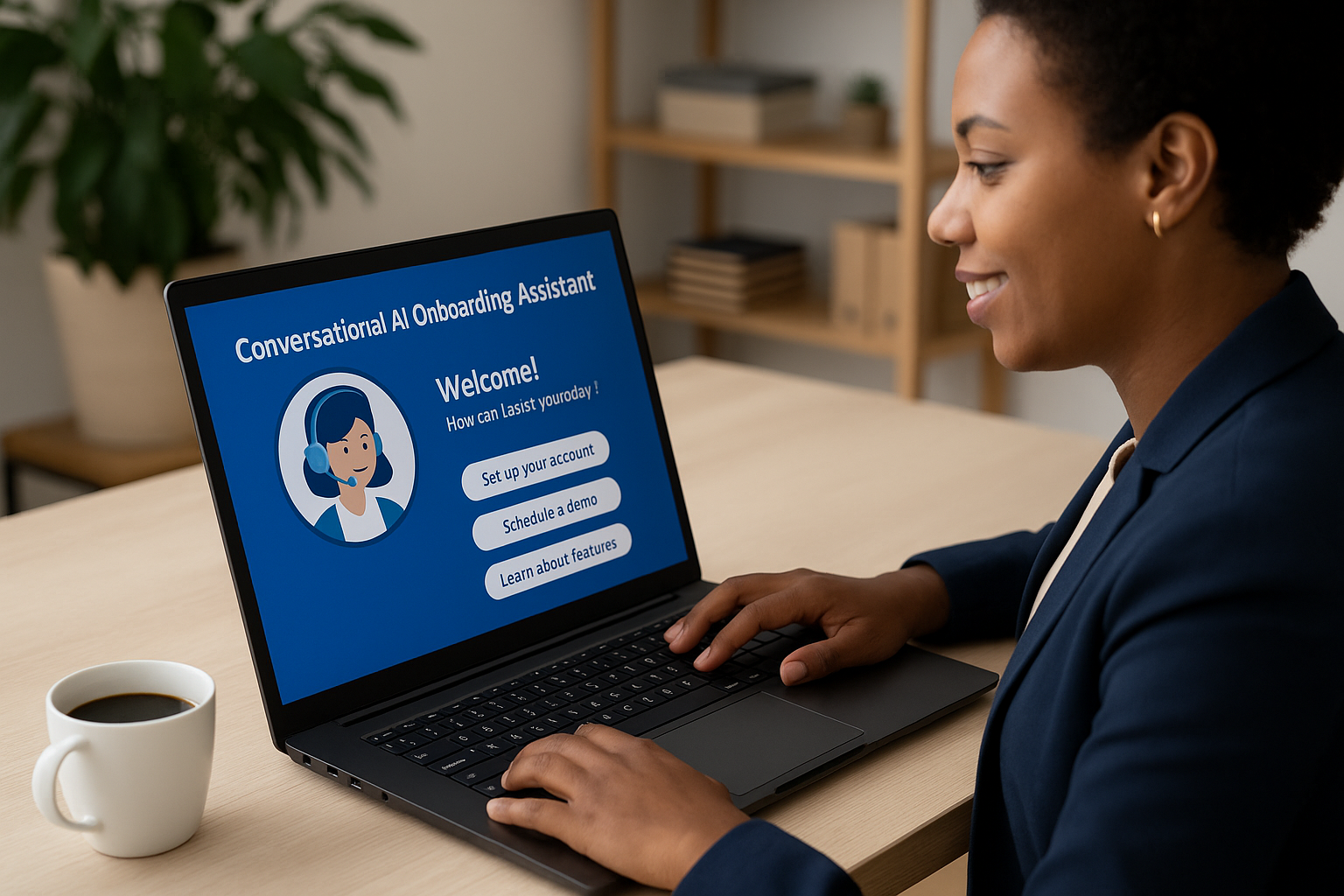
Introduction
First impressions can make or break a relationship. That’s especially true in business. When customers sign up for your product or service, their first few interactions define whether they’ll become loyal advocates or quiet quitters. Onboarding, that early-stage experience, is where the magic—or disaster—happens.
But here’s the kicker: traditional onboarding processes are often clunky, slow, and frustrating. Long wait times. Unclear next steps. Impersonal emails. Sound familiar?
This is where Conversational AI enters the chat—literally. It’s not just about bots anymore. It’s about smart, context-aware systems that engage users in natural, two-way conversations from the moment they say “Hello.”
Let’s dig into how conversational AI is revolutionizing onboarding and what it means for your customer experience (CX).
Understanding Conversational AI
So, what exactly is conversational AI?
In plain English, it’s the technology that allows machines to talk like humans. It goes beyond rule-based scripts. Using natural language processing (NLP), machine learning, and context awareness, conversational AI understands intent, remembers previous interactions, and responds accordingly.
Unlike the static chatbots of yesteryears that just give canned replies, conversational AI listens, learns, and adapts. Think Siri, Alexa, or ChatGPT—but fine-tuned for business interactions and onboarding journeys.
It’s the friendly guide you wish every user had when navigating new platforms or services.
Why Onboarding Needs a Makeover
The traditional onboarding experience hasn’t evolved much over the last decade. Here’s the usual drill: you sign up, receive a generic welcome email, and then get dumped into a dashboard with zero guidance.
Maybe there’s a help article. Maybe not. Maybe support replies in an hour. Maybe never.
That’s not onboarding. That’s abandonment in disguise.
Poor onboarding leads to:
-
Frustration and confusion
-
Drop-offs before activation
-
Overloaded support teams
-
Increased churn
Customers want clarity. Speed. Human-like support. That’s where conversational AI flips the script.
The Role of Conversational AI in Modern Onboarding
Conversational AI steps in right from the beginning. Imagine landing on a platform and being greeted by a smart assistant that knows your name, understands your goals, and guides you step by step.
No need to submit a ticket. No “Please wait 2 business days.” It’s all about real-time, human-like interaction.
These AI systems respond to questions, give product tours, schedule demos, and help users activate features—all without human intervention (unless needed).
And the best part? It’s all tailored. The AI adapts based on where the user is in their journey.
Building Trust Through Personalized Interactions
When onboarding feels personal, users stick around.
Conversational AI allows brands to move away from “Dear User” to “Hey Sarah, looks like you’re interested in setting up a campaign—need help with that?”
It reads user behavior, adjusts tone, offers multilingual support, and speaks like a real human—warm, helpful, not robotic.
This kind of empathy at scale builds trust. Fast.
Conversational AI Across Onboarding Channels
Customers don’t just live on your website. They use mobile apps, messaging platforms like WhatsApp, and social media. Your onboarding shouldn’t be confined to a single channel.
Conversational AI meets users where they are.
Whether it’s in-app chat, voice assistants, or Instagram DMs, AI ensures a consistent, seamless experience across touchpoints. Behind the scenes, it connects with CRMs and support systems to keep everything unified.
One journey. Multiple channels. Zero friction.
Enhancing Self-Service with AI
Let’s be honest—most people prefer to solve things on their own. But only if it’s fast and easy.
Conversational AI powers intelligent self-service by guiding users to relevant content, answering repetitive questions, and providing step-by-step assistance—all instantly.
It’s like having a personal assistant in your pocket who’s always awake, always friendly, and never tired.
Driving Proactive Onboarding Experiences
The best onboarding isn’t reactive—it’s proactive.
AI can send reminders if a user forgets to complete setup. It can offer a demo if it senses confusion. It can celebrate milestones (“You just completed your first campaign—way to go!”) and nudge users toward the next step.
It’s not just a chatbot—it’s a customer success engine on autopilot.
Real-Life Applications and Success Stories
A fintech company slashed onboarding time from 7 days to 2 hours using conversational AI to guide customers through KYC.
A SaaS brand used AI to increase feature adoption by 45% through automated product tours.
A telecom player deployed voice AI for SIM activation, reducing support calls by 60%.
These aren’t future dreams—they’re real wins happening today.
Measuring the ROI of AI Onboarding
What gets measured, gets improved.
Conversational AI impacts metrics like:
-
Time to Value (TTV): How fast users reach their first success
-
Net Promoter Score (NPS): How likely they are to recommend you
-
Churn Rate: Whether they stick around
-
Support Load: How many tickets get deflected
When AI handles the heavy lifting, your team can focus on deeper customer relationships.
Overcoming Challenges in Implementation
No tech is perfect.
You’ll need to train your AI, monitor conversations, and ensure it reflects your brand voice. Striking a balance between automation and human support is key.
And yes, privacy matters. Ensure your AI platform follows GDPR, CCPA, and other compliance standards.
Start small. Learn fast. Scale smart.
Designing an AI Onboarding Strategy
Don’t just deploy AI—design a strategy.
Start by mapping the customer journey. Identify drop-off points and pain areas. Choose the right AI tools based on your audience and platforms.
Most importantly, gather feedback. Let users tell you what works and what feels robotic. Then optimize.
Conversational AI thrives on iteration.
Future of AI-Powered Onboarding
What’s next?
-
Emotion AI will allow bots to sense frustration or excitement and adjust their responses accordingly.
-
Hyper-personalization will offer journeys tailored not just to roles—but to individual personalities.
-
Voice-first onboarding will make it easy for non-tech-savvy users to get started with just a few spoken commands.
The onboarding of tomorrow will feel less like a process—and more like a conversation with a friend.
Conclusion
Conversational AI is no longer a nice-to-have—it’s a must-have for modern onboarding. It transforms static, frustrating user experiences into dynamic, engaging journeys.
Customers don’t want to read guides or wait on hold. They want answers. Now. In their language. On their terms.
And when you give them that? They don’t just onboard. They stay.
FAQs
1. How is conversational AI different from traditional chatbots?
Traditional chatbots follow rules. Conversational AI understands context, adapts to user behavior, and engages in natural, human-like dialogue.
2. Can conversational AI fully replace human support in onboarding?
Not entirely—but it can handle 80% of repetitive onboarding tasks, freeing humans for complex or emotional interactions.
3. Is conversational AI suitable for small businesses?
Absolutely. Many AI platforms offer affordable solutions that scale as your business grows.
4. How do I know if my AI onboarding strategy is working?
Track metrics like activation rate, support ticket reduction, TTV, and user feedback.
5. Is it safe to use conversational AI for sensitive data during onboarding?
Yes—if you choose compliant platforms that offer encryption, data masking, and follow regulatory frameworks like GDPR.

